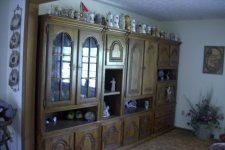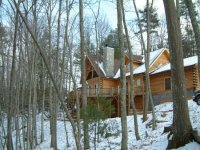We have a log home near Pittsburgh, PA. Bought it in 1998, from a young couple who started construction in 1996, but were having financial troubles. We continue to finish it, we love it, and yes, there are pros and cons.
It is a custom design from Original Log Homes out of British Columbia. It has 12-18" diameter round logs (Engelman Spruce) with Swedish saddle knotch locking corners. This house isn't going anywhere unless it burns to the ground! The logs are cut in British Columbia, and air dried for 2 years. Then they design and build your house in British Columbia. They number the logs, tear it apart, load it on a truck, and drive it to your site. They hire a local crane, and erect the frame. The first couple had already built a basement, and did the rest of the work themselves (roof, interior, plumbing, HVAC, electricity, cable, phone, gas lines, etc.).
When we bought the home, we were told that settling would occur for seven years from the date it was constructed. Therefore, most of the trim work was not completed where it would meet a log wall. Where it was done, it is off, and will need to be redone. The home seems to be done settling. The doors that we had realligned in 1998 are fine. The spaces left above the doors and windows seems to have stabilized, so these can be permanently covered, now. The effects of settling don't seem to be too big a deal - I think the first 2 years are the worst. The finish is really important - the first couple just put a coat of CWF on it, which is good for about 2 years. We talked to I-Wood Care in New York, and they sent us a guide on how to redo the finish (using products that they sell, of course!) We sprayed a mixture of bleach, Tri-Sodium Phosphate (TSP), and water with a garden sprayer, power-washed the house, and then (very important) sprayed 2 coats of PeneTreat (a borate treatment which repels mildew and insects) with the garden sprayer. Then we used an airless sprayer followed by brushes to apply Sherwin Williams Woodscapes Stain. This is supposed to be good for 5 years, and we shouldn't ever have to do the Penetreat again. After 1 year, the house still looks brand new. Now that the house is done settling, we will caulk all of the log seams and joints. The real fight on the finish is waged by sunlight, not rain. Big roof overhangs are the key to keeping the logs looking new - just good design. Speaking of design, you just have to be smart about providing enough closets and storage space - we are very happy with our space, but a full basement and attached garage or mud room are a good idea.
Insects are a fact with log homes, so we pay a pest company to come out once a quarter, for about $100 per visit. Then we keep our eye out for wasp nests and spray when we find them. The pest company has chemicals that really limit the wasps and bore bees. A note about bore bees - they usually bore UP, so roof overhangs with wood soffets are usually where they attack. Our solution is to use a brown aluminum or vinyl soffet material except where the dramatic overhangs have very nice tongue and groove board. I have not seen any bore bees this year, after 1 year of the pest company services.
Round logs have lots of horizontal surface, and therefore need to be dusted frequently. I think that's why square and D-shaped logs are so popular, but our round logs look incredible and we love them!
People mentioned quiet - no kidding! When we first moved in, a huge storm was raging one night, and we didn't even know until a door blew open! These homes are so solid - you just know it could last forever if taken care of.
We studied log homes for a long time before buying one already completed. The package prices have to be compared really closely between companies so you can see exactly what is included. I was told the cost to have a home constructed would cost about the same as the package materials, not including well and septic and other hookups. You should probably pick a manufacturer who has been doing it a while and has a representative in your area that you think you can work well with.
It's a good idea to know how you are going to light the interior spaces because all those logs make it dark! We have had good success with track lighting. We love our home, because there are a lot of white, drywall walls inside - this contrasts well with the natural spruce color of the logs, and provides some more light. It's a good idea.
We have 40 acres of woods in a fairly rural area, with about 2 acres of yard, and neighbors close by. The setting is perfect for a log home, and I think finding a buyer would not be a problem because it looks "right" in its setting. Certain types of log homes would just look silly in a suburban housing plan.
So, my overall opinion is that log homes require more maintenance than a brick home, but if designed and treated correctly, are wonderful places to live. Hope this helps somebody thinking about it.
Brad
Satoh S650G


